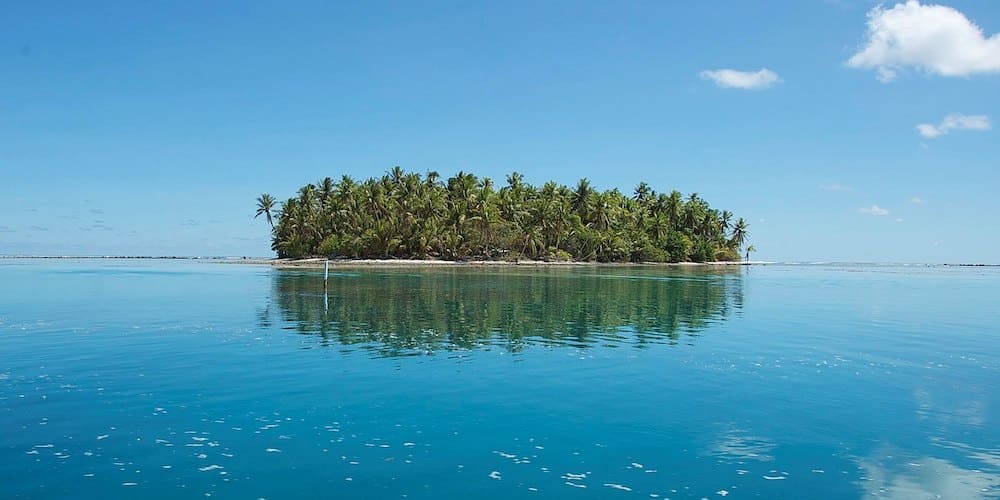Tokelau

Tokelau, known previously as the Union Islands is a dependent territory of New Zealand in the southern Pacific Ocean. It consists of three tropical coral atolls: Atafu, Nukunonu, and Fakaofo. They have a combined land area of just 10 km2 (4 square miles). In addition to these three, Swains Island (Olohega), which forms part of the same archipelago, is the subject of an ongoing territorial dispute; it is currently administered by the United States as part of American Samoa. Tokelau lies north of the Samoan Islands, east of Tuvalu, south of the Phoenix Islands, southwest of the more distant Line Islands, and northwest of the Cook Islands.
Tokelau has a population of approximately 1,500 people; it has the fourth-smallest population of any sovereign state or dependency in the world. As of the 2016 census, around 45% of its residents had been born overseas, mostly in Samoa or New Zealand. Approximately 94% of the population speak Tokelauan as their first language. The territory has the smallest economy of any nation, but is a leader in renewable energy, being the first 100% solar-powered nation in the world.
Tokelau comprises three atolls in the South Pacific Ocean between 171° and 173° W longitude and 8° and 10° S latitude, approximately midway between Hawaii and New Zealand 500 km (311 miles) north of Samoa. The islands are Atafu, at one time known as the Duke of York Group, Nukunonu, also the Duke of Clarence Group, and Fakaofo, once Bowditch Island. There are no ports or harbours for large vessels, however, all three atolls have a jetty to and from which supplies and passengers are shipped. Tokelau lies in the Pacific typhoon belt.
Tokelau is in a completely different time zone to most of New Zealand, being 10 hours behind Coordinated Universal Time (UTC) rather than 12 hours in front, meaning a 22 hour time difference for much of the year (New Zealand has daylight saving time (DST) for part of the year while Tokelau never participates). Tokelau is in the same time zone as the Cook Islands and Hawaii rather than neighbouring Samoa and American Samoa.
Local industries include small-scale enterprises for copra production, wood work, plaited craft goods, stamps, coins, and fishing. Agriculture and livestock produces coconuts, copra, breadfruit, papayas, bananas, figs, pigs, poultry and a few goats. Many Tokelauans live in New Zealand and support their families in Tokelau through remittances.

©AusAID, CC BY 2.0 via Wikimedia Commons
Birding Tokelau
Tokelau is located in the Western Polynesian tropical moist forests ecoregion. The atolls of Tokelau provide habitat for 38 indigenous plant species, over 150 insect species and 10 land crab species. One of the greatest threats to biodiversity is posed by introduced mammalian predators such as the Polynesian Rat. Tokelau has declared its entire exclusive economic zone of 319,031 km2 a shark sanctuary.
Tokelau has a moist tropical climate year-round, with an average temperature of 28 °C and a mean annual rainfall of over 120 inches. The atolls consist of coral rubble of different sizes, with poor quality soil overlying coral rock. Plant diversity is low, with forest on the inner side of the atolls comprising mainly coconut palm, along with other tropical trees like Cordia subcordata, Pisonia grandis, Guettarda speciosa, and Pandanus. Undergrowth mainly consists of bird’s-nest fern (Asplenium nidus). Vegetation nearer the beach is more diverse, with very little soil and plants like Scaevola taccada and Morinda citrifolia.
Only 34 bird species have ever been reported and only one naturally occurring landbird is resident – Pacific Imperial Pigeon, although Long-tailed Koel occurs annually. Red Junglefowl is feral. There are 8 shorebirds and the rest seabirds. There are three species that dominate Tokelau’s breeding bird population, Black Noddy or lakia, the Brown Noddy or gogo and White Tern or akiaki. A survey revealed that each of these birds had been found in mating pairs numbering well into the thousands on each of Tokelau’s three atolls. Black-naped Tern can be found in many different locations, but it very rarely ventures inland. As it nests on the ground it can be vulnerable to human and predator disturbance as well as flooding or other unpredictable weather patterns.
-
Wikipedia
GNU Free Documentation License
https://en.wikipedia.org/wiki/Tokelau
-
Number of bird species: 32
(As at January 2025)
-
Avibase
PDF ChecklistThis checklist includes all bird species found in Tokelau , based on the best information available at this time. It is based on a wide variety of sources that I collated over many years. I am pleased to offer these checklists as a service to birdwatchers. If you find any error, please do not hesitate to report them. -
eBird
PDF ChecklistThis checklist is generated with data from eBird (ebird.org), a global database of bird sightings from birders like you. If you enjoy this checklist, please consider contributing your sightings to eBird. It is 100% free to take part, and your observations will help support birders, researchers, and conservationists worldwide.
-
A Guide to the Birds of Fiji and Western Polynesia: Including American Samoa, Niue, Samoa, Tokelau, Tonga, Tuvalu and Wallis and Futuna
| By Dick Watling | Published byDick Watling | 2005 | Edition 2 | Paperback | 272 pages, 16 col plates, figs, tabs, maps | Out of Print | ISBN: 9789829030047 Buy this book from NHBS.com
-
List of birds of Tokelau
WebsiteThis is a list of the bird species recorded in Tokelau. The avifauna of Tokelau includes a total of 29 species, of which 1 has been introduced by humans, and 5 are rare or accidental. 2 species are globally threatened

